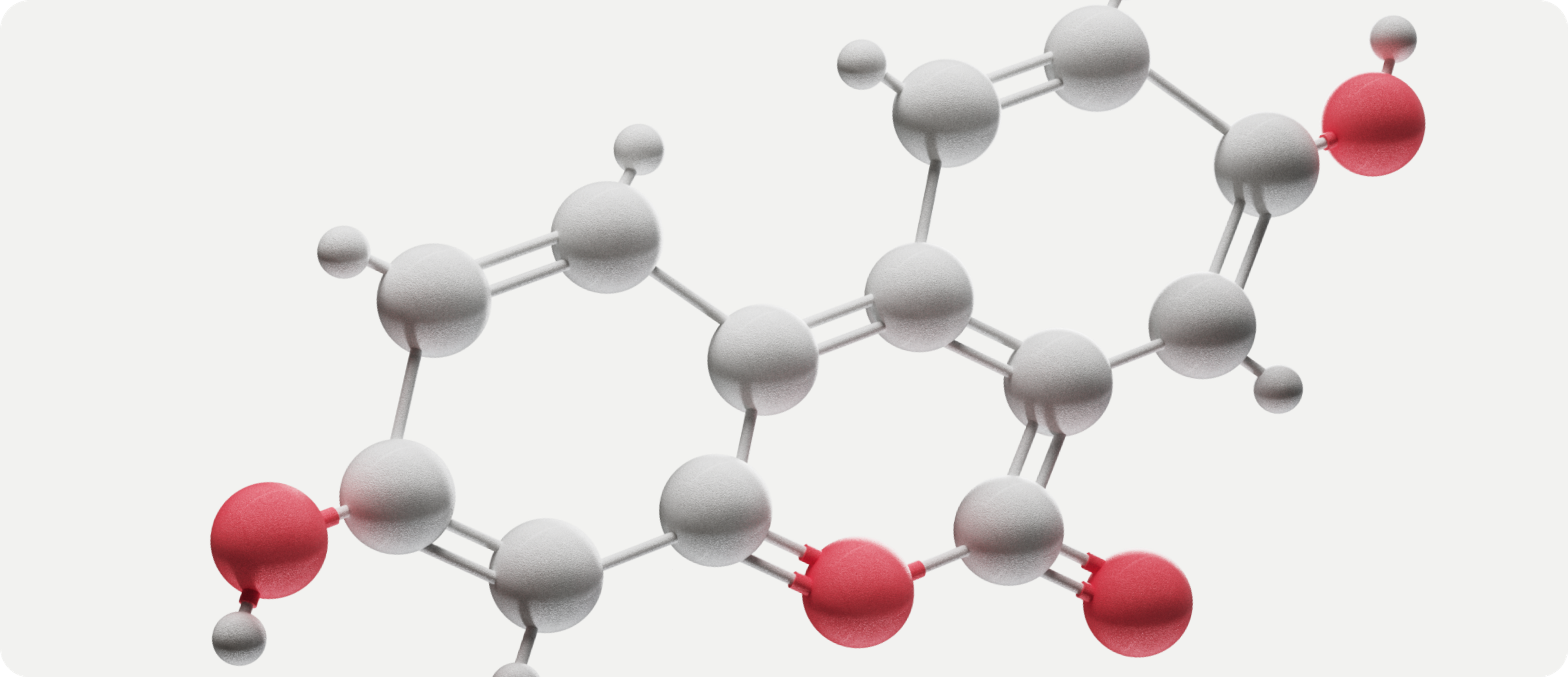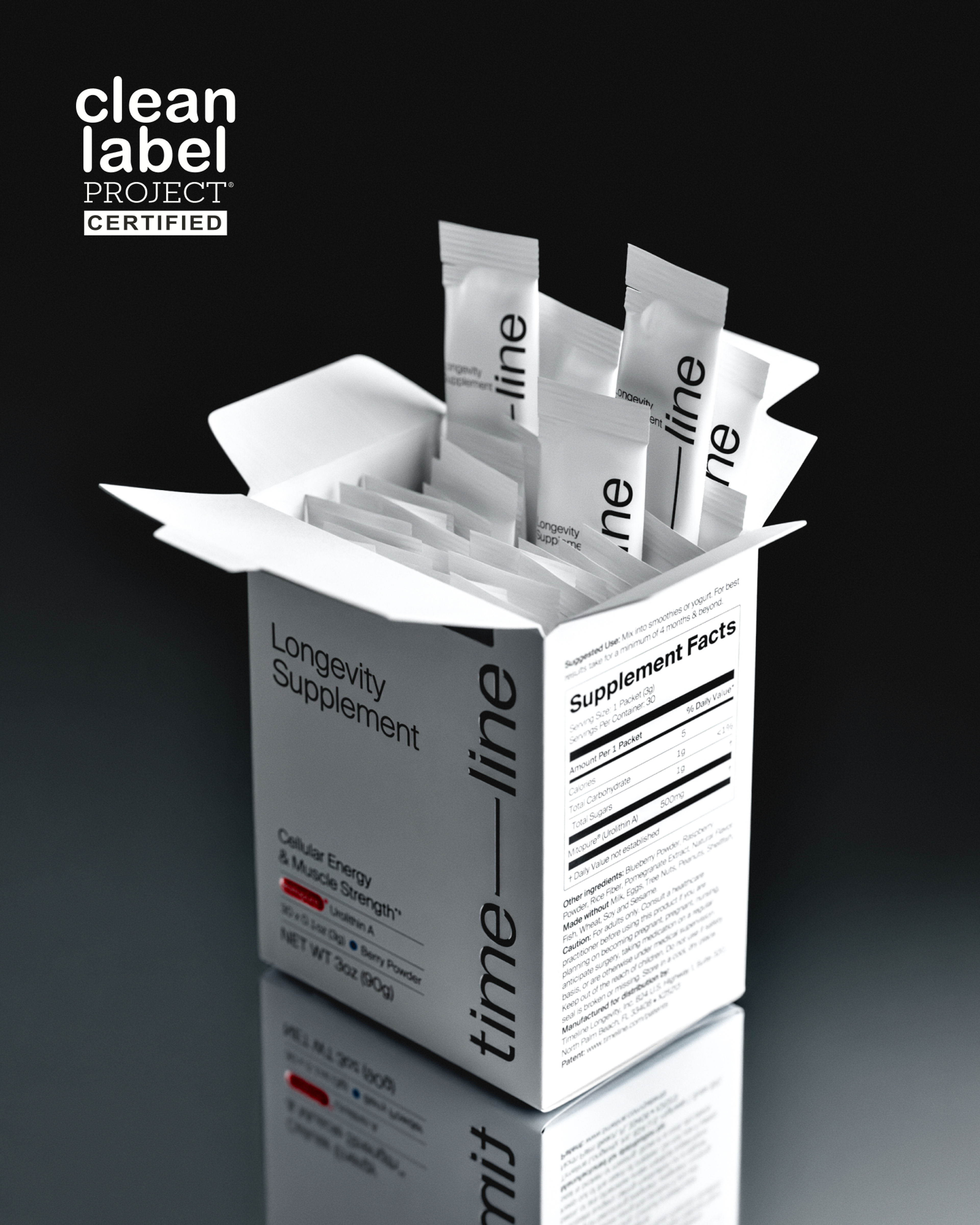Understanding and Managing Menopause Skin Changes
Learn how menopause impacts skin health and discover science-backed tools like Mitopure® to keep skin vibrant and healthy.

What to know
The decrease in estrogen levels during menopause significantly affects skin health and appearance.
Menopause can cause various skin issues such as dryness, itchiness, wrinkles, increased sensitivity, adult acne, and uneven pigmentation due to hormonal fluctuations and reduced cellular energy.
Effective menopause skin care includes sun protection, hydrating products with powerful ingredients, and eating a healthy diet.
Urolithin A (UA), found in Timeline’s patented Mitopure® products, can boost cellular energy and is clinically studied in women.
Menopause brings more than just hot flashes—its impact is far-reaching, influencing nearly every aspect of a woman’s body, including the skin. While many associate menopause with women in their 40s and 50s, perimenopause—the transition leading up to menopause—can begin as early as age 35 and extend over two decades.[1]
During this time, fluctuating hormones can cause a host of changes, including in the skin. In fact, skin changes may be one of the earlier signs of declining estrogen levels. As estrogen levels decline, visible signs like dryness, fine lines, and sagging often become more pronounced.

Skin Changes During Menopause
Estrogen is an MVP for skin health. It plays a role in everything from collagen stimulation,[2] oil gland regulation, antioxidant defense, and even maintaining mitochondrial health in the skin.[3] During the menopausal transition, estrogen levels drop significantly, which can contribute to cellular aging and menopausal skin changes.[4]
What Happens to the Skin During Menopause?
We know that menopause causes hot flashes, menopause-related fatigue, and those dreaded changes in weight, muscle, and body composition. But did you know it has a similar effect on our skin?
Many skin changes during menopause are due to reduced cellular energy. [5]Estrogen is important for mitochondrial health, our cellular powerhouses. Additionally, lower estrogen levels result in reduced collagen production, reduced oil gland regulation, and more oxidative stress.[6]

Skin changes due to menopause
Everyone will experience different skin changes during menopause, but here are some of the more common effects:
- Dryness and Itchiness: Menopause and dry skin are often associated with one another. As estrogen levels drop,[7] the skin loses its ability to retain moisture.
- Wrinkles and Fine Lines: Estrogen is a key player in the production of collagen, so it’s not surprising that as estrogen levels decline, so does the level of collagen. In fact, collagen levels can drop up to 30% during the first five years of the menopausal transition, leading to the development of fine lines and wrinkles.[8]
- Increased Sensitivity: Studies have shown that as estrogen drops, inflammation increases.[9] Combined with changes in skin pH, many women experience increased skin sensitivity over the age of 50.[10]
- Adult Acne: Hormonal fluctuations during menopause may disrupt the balance of oil production in the skin, contributing to the development of adult acne.[11] It’s also possible for you to experience reduced oil production and acne simultaneously during the early transition.
- Uneven Pigmentation: Pigmentation or melasma is one of the many skin changes associated with menopause. [12]Age spots due to photodamage can also appear at this time, contributing to the development of dark spots and uneven skin tone.[13]
How to Take Care of Your Skin During Menopause
Managing menopausal skin changes is all about promoting skin health while preventing skin degradation. Let’s take a closer look at using some proven ways you can target skin health during menopause and beyond:
Use sunscreen daily
Sunscreen is vital at any age, but during menopause, it may be even more important to protect the skin from UV damage. Studies suggest that as estrogen levels decline, the skin's natural defenses weaken, making it more susceptible to oxidative stress from sun exposure. It’s estimated that around 80% of skin aging is attributed to environmental factors like UV rays. Incorporating a mineral-based sunscreen into your routine can provide protection, helping to prevent further damage and maintain healthier, more youthful-looking skin.

Urolithin A
Urolithin A (UA) may be an excellent tool to address aging skin changes. Urolithin A is a natural compound produced by our gut microbiome when we consume foods rich in polyphenols, such as pomegranates. It works by re-energizing our skin cells at the source, and when you have healthier, more energetic mitochondria, your cells act in a more youthful way.
Urolithin A targets the root causes of aging, boosting cellular energy, enabling skin cells to produce more collagen, and helping to protect the skin from photodamage.[14]
Timeline’s Skincare Line is powered by Mitopure®, a clinically tested formulation of Urolithin A. And, Timeline's products have specifically been tested on midlife women's skin. In a clinical trial on middle-aged women (average age of 58.6 years), participants noticed an improvement in the visible signs of aging after just two weeks, with a significant impact after 8 weeks. [15]
Supercharge your moisturizer
As estrogen levels decline, the skin's ability to retain moisture decreases, leading to dryness. [16]This can also make the appearance of fine lines and wrinkles appear more pronounced. Using a moisturizer with deeply hydrating ingredients can help restore balance and lock in moisture. Timeline’s Skincare, formulated with shea butter and squalane, works effectively to nourish the skin and reinforce its moisture barrier, leaving the skin smoother and more hydrated.

Mito-Biotic™ Barrier Cream
4.7 · 157 reviews
Buttery, protective moisturizer with peptides
Use products for sensitive skin
Many “anti-aging” skincare products marketed to midlife women contain harsh ingredients like retinol, which can irritate the skin or make it more sensitive to the sun. This is not the case with Urolithin A. Studies found no skin irritation or sensitization after a 6-week Human Repeat Insult Patch Test with a 1% Mitopure-based cream. This is the amount of Mitopure found in Timeline's Skincare Line.
Additionally, our products are free from other harsh ingredients, like SLS and SLES, as well as synthetic fragrances and dyes.

Eat a skin-healthy diet
Skin health is not just about what you put on your skin; it’s also about how you nourish your body. Several foods have been identified to help support the skin during the aging process. People who regularly eat foods like fatty fish, nuts, green tea, pomegranates, and citrus fruit tend to have more youthful,[17] healthier-looking skin, while a diet high in ultra-processed foods is linked to accelerated skin aging.[18]
5 Reasons Why Timeline Skincare May Be Perfect for Aging Skin
If you are looking for a skincare line to support aging skin changes that may be due to menopause, look no further than Timeline. Here are five reasons why:
- Reduction in Fine Lines and Wrinkles: Users of Mitopure saw visible improvements in fine lines and wrinkles in just two weeks. By eight weeks, the improvement was statistically significant compared to placebo.
- Better Collagen Production: Mitopure upregulates the genes responsible for collagen assembly and organization, which is essential for keeping skin firm and reducing the appearance of wrinkles.
- Protects Against Photodamage: Sun exposure is the leading cause of skin aging, but studies show that topical Mitopure helps skin cells become more resilient, protecting against harmful UV rays and sun damage.
- Gentle Power: Unlike many skincare ingredients that can cause irritation, Mitopure delivers potent results without compromising skin comfort.
- Revitalizes, Hydrates, and Brightens the Skin: In a 3-week trial of 30 healthy women aged 40 to 65, Timeline’s skincare line improved skin health by targeting aging at its root cause, leaving skin noticeably more hydrated and radiant.

Menopause brings a host of changes, and skin health is no exception. The good news is that with simple lifestyle habits like daily sun protection and a healthy diet, you can help your skin stay radiant and resilient through this transition. Choosing the right skincare products, such as Timeline’s Mitopure-powered line, can also support aging skin and strengthen its overall skin vitality.
Learn more about the power of Mitopure for your skin.
Authors

Written by
Freelance writer

Reviewed by
Director Science Communications
References
- ↑
Aninye IO, Laitner MH, Chinnappan S; Society for Women's Health Research Menopause Working Group. Menopause preparedness: perspectives for patient, provider, and policymaker consideration. Menopause. 2021 Jun 28;28(10):1186-1191. doi: 10.1097/GME.0000000000001819. PMID: 34183564; PMCID: PMC8462440.
- ↑
Thornton M. J. (2013). Estrogens and aging skin. Dermato-endocrinology, 5(2), 264–270. https://doi.org/10.4161/derm.23872
- ↑
Klinge C. M. (2020). Estrogenic control of mitochondrial function. Redox biology, 31, 101435. https://doi.org/10.1016/j.redox.2020.101435
- ↑
Richardson, H., Ho, V., Pasquet, R., Singh, R. J., Goetz, M. P., Tu, D., Goss, P. E., Ingle, J. N., & MAP.3 Investigators (2020). Baseline estrogen levels in postmenopausal women participating in the MAP.3 breast cancer chemoprevention trial. Menopause (New York, N.Y.), 27(6), 693–700. https://doi.org/10.1097/GME.0000000000001568
- ↑
Lejri, I., Grimm, A., & Eckert, A. (2018). Mitochondria, Estrogen and Female Brain Aging. Frontiers in aging neuroscience, 10, 124. https://doi.org/10.3389/fnagi.2018.00124
- ↑
Thornton M. J. (2013). Estrogens and aging skin. Dermato-endocrinology, 5(2), 264–270. https://doi.org/10.4161/derm.23872
- ↑
Thornton, M. J. (2013). Estrogens and aging skin. Dermato-Endocrinology, 5(2), 264–270. https://doi.org/10.4161/derm.23872
- ↑
Thornton M. J. (2013). Estrogens and aging skin. Dermato-endocrinology, 5(2), 264–270. https://doi.org/10.4161/derm.23872
- ↑
Abildgaard, J., Tingstedt, J., Zhao, Y., Hartling, H. J., Pedersen, A. T., Lindegaard, B., & Dam Nielsen, S. (2020). Increased systemic inflammation and altered distribution of T-cell subsets in postmenopausal women. PloS one, 15(6), e0235174. https://doi.org/10.1371/journal.pone.0235174
- ↑
Caring for your skin in menopause. American Academy of Dermatology Association. Retrieved September 24, 2024, from https://www.aad.org/public/everyday-care/skin-care-secrets/anti-aging/skin-care-during-menopause (https://www.google.com/url?q=https://www.aad.org/public/everyday-care/skin-care-secrets/anti-aging/skin-care-during-menopause&sa=D&source=docs&ust=1727892463110144&usg=AOvVaw2ZSc7bro4NFRNiiJEeV0uR)
- ↑
Khunger N, Mehrotra K. Menopausal Acne - Challenges And Solutions. Int J Womens Health. 2019 Oct 29;11:555-567. doi: 10.2147/IJWH.S174292. PMID: 31754313; PMCID: PMC6825478.
- ↑
Kamp, E., Ashraf, M., Musbahi, E., & DeGiovanni, C. (2022). Menopause, skin and common dermatoses. Part 2: skin disorders. Clinical and experimental dermatology, 47(12), 2117–2122. https://doi.org/10.1111/ced.15308
- ↑
Caring for your skin in menopause. American Academy of Dermatology Association. Retrieved September 24, 2024, from https://www.aad.org/public/everyday-care/skin-care-secrets/anti-aging/skin-care-during-menopause (https://www.google.com/url?q=https://www.aad.org/public/everyday-care/skin-care-secrets/anti-aging/skin-care-during-menopause&sa=D&source=docs&ust=1727892463104436&usg=AOvVaw0dAv8odf999pSZIdr2Tk_U)
- ↑
Topical application of Urolithin A slows intrinsic skin aging and protects from UVB-mediated photodamage: Findings from Randomized Clinical Trials D D’Amico, AM Fouassier, J Faitg, N Hennighausen, M Brandt, D Konstantopoulos, C Rinsch, A Singh medRxiv 2023.06.16.23291378; doi: https://doi.org/10.1101/2023.06.16.23291378
- ↑
Topical application of Urolithin A slows intrinsic skin aging and protects from UVB-mediated photodamage: Findings from Randomized Clinical Trials D D’Amico, AM Fouassier, J Faitg, N Hennighausen, M Brandt, D Konstantopoulos, C Rinsch, A Singh medRxiv 2023.06.16.23291378; doi: https://doi.org/10.1101/2023.06.16.23291378
- ↑
Caring for your skin in menopause. American Academy of Dermatology Association. Retrieved September 24, 2024, from https://www.aad.org/public/everyday-care/skin-care-secrets/anti-aging/skin-care-during-menopause
- ↑
Michalak M, Pierzak M, Kręcisz B, Suliga E. Bioactive Compounds for Skin Health: A Review. Nutrients. 2021; 13(1):203. https://doi.org/10.3390/nu13010203 (https://www.google.com/url?q=https://doi.org/10.3390/nu13010203&sa=D&source=docs&ust=1727892463102769&usg=AOvVaw3jrAzJNpI2hxe0xT9Cp3RW)
- ↑
Cao C, Xiao Z, Wu Y, Ge C. Diet and Skin Aging-From the Perspective of Food Nutrition. Nutrients. 2020 Mar 24;12(3):870. doi: 10.3390/nu12030870. PMID: 32213934; PMCID: PMC7146365.

·
Should You Exfoliate in the Winter?

Video











